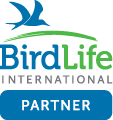Continuing on with our series looking at the differences people are making for nature in Ireland, Tara Adcock, Urban Birds Project Officer for BirdWatch Ireland, sat down with Cheryl and Alan Poole to chat about the work they are doing for nature on their dairy farm in Gorey, Co. Wexford…
Cheryl and Alan Poole are doing what many feel is impossible – earning a living from an intensive 103-acre dairy farm, milking 72 cows, while also dedicating 20% of the land as space for nature and carrying out several conservation projects.
 Alan and Cheryl Poole, with their family. (Matthew Moylan)
Alan and Cheryl Poole, with their family. (Matthew Moylan)
Alan’s family has owned the farm outside Gorey in Co. Wexford for over 300 years, but as the youngest of four he was never expected to take over. Instead, he studied environmental science, before completing a PhD in Red Squirrel ecology, where he met Cheryl who studied chemistry before doing a PhD in research chemistry.
Fast forward several years and Alan’s brother needed to have a hip replacement, and so Alan and Cheryl were asked to come back to run the farm.
From the beginning they began to make small changes to provide more space for nature on the farm. ‘That’s how we started…,’ says Cheryl, ‘we got the hedge trimmer to stop trimming the tops of the hedges… that was what 18 years ago, and now we have these massive, big mature trees that flower, which creates food for insects, which creates food for birds…’
 Hedgerows that have been allowed to grow on the Poole farm. (Cheryl Poole).
Hedgerows that have been allowed to grow on the Poole farm. (Cheryl Poole).
Letting the hedgerows grow was the first initiative for nature, but it was by far the last. Alan and Cheryl began to take part in other biodiversity initiatives.
These initiatives included planting native trees, putting up bat and bird boxes and leaving plants such as nettles and thistles along the ditches. They then became Biodiversity Ambassadors for Tirlán and notably, became involved with the River Slaney Project. This project is an initiative by Tirlán to enhance the water quality of the River Slaney Catchment area.
The River Slaney Project was developed to support Ireland’s campaign to retain the derogation on nitrate use. While an end to this derogation would affect the Poole’s farming income, it is not the main reason they got involved in the project. They participated as water quality matters to them. It is important for their kids who play in the river, for people who use the river as a resource, for the environment, and for the planet.
 A school group on the Pooles’ section of the River Bann. (Cheryl Poole).
A school group on the Pooles’ section of the River Bann. (Cheryl Poole).
All their work along with others on the River Bann has earned the river a blue dot at the Poole’s farm, meaning that their section of the River Bann is considered pristine, something which the couple are extremely proud of.
It was the work with Tirlán which initially boosted their confidence in what they were doing. However, it was meeting Mark Stanley that provided the catalyst for much of the conservation work which followed.
 Mark Stanley. (Selfie).
Mark Stanley. (Selfie).
 Mark Stanley ringing a Barn Swallow. (Cheryl Poole).
Mark Stanley ringing a Barn Swallow. (Cheryl Poole).
Mark initially met Alan and Cheryl during an event hosted on the Poole’s farm. Alan had been keen to discuss doing more for nature at a Dairy Discussion Group of which he’s a member. He got in touch with the group facilitator, Colm Doran, asking him to include an item on the next AGM agenda. However, the AGM came and went with no mention of it, and Alan thought ‘well that’s me put back in my box.’ However, Colm had bigger ideas.
Instead of discussing it at the AGM, Colm thought it would be better to showcase what farmers can do for nature on the Pooles’ farm. Several groups were invited including the Wexford Barn Owl Group. In addition, about 120 farmers attended.
 Open day on the Poole farm. (Cheryl Poole).
Open day on the Poole farm. (Cheryl Poole).
Mark, who sadly passed away two years ago, was part of the Wexford Barn Owl Group. About two weeks before the Poole’s event he gave a talk to the Wexford Naturalist Field Club, where he, ‘a bit dismissively’, laughs Alan, mentioned that he would be attending ‘some farmer thing about biodiversity’ in Gorey.
When he arrived on the farm, Alan and Cheryl got the distinct impression he had filed them away under the heading of ‘intensive dairy farmers who didn’t care about anything other than grass, grass, and grass…’ Alan says with a laugh.
Mark began to reassess the Pooles however, when asking about Kingfisher on the River Slaney, Alan told him he’d be guaranteed to see Kingfisher between the two bridges. Sure enough, Mark saw the Kingfisher where Alan had predicted, got his nets from the car and managed to ring the bird.
And Mark was hooked. He began to work with Alan and Cheryl on a Barn Owl nest box project. Today they have a nest box about 50m from the house. Barn Owls raised two chicks in it this year, both of which have been ringed.
Swifts were the next species to benefit from the friendship. Alan had spotted Swifts around the farm and asked Mark if there was anything they could do for them, to which Mark replied, ‘Definitely!’
 Swift. (Piotr Rak).
Swift. (Piotr Rak).
The following Spring they installed three boxes and a caller system at the gable end of a shed. The very first year they had Swifts investigating the boxes. Cheryl laughs that every time Mark would see a Swift investigating one of the boxes he’d stand in the middle of the field shouting, ‘Go in, you stupid bird!’, a tag line which the Pooles have since embraced. It has even spread to James O’Neill, who has followed in Mark’s footsteps on the farm, ringing birds and installing nest boxes.
 James O’Neill and colleagues ringing Sand Martins on the Poole farm. (Cheryl Poole).
James O’Neill and colleagues ringing Sand Martins on the Poole farm. (Cheryl Poole).
In 2024, they installed another three Swift nest boxes on the gable end of the farm. When installing Swift nest boxes the previous spring, they had found they needed to make a substantial cut in the metal sheeting of the barn.
This time around they installed a ‘porch’ on each Swift nest box entrance so that a much smaller hole would need to be cut into the metal sheeting, making the boxes easier to fit and potentially more attractive to other farmers.
 Swift nest boxes in the gable end of a shed on the Poole farm. The three Swift nest boxes installed the first year are on the bottom, covered with metal sheeting to waterproof them. The second set of nest boxes are above, with a ‘porch’ installed at the nest entrance, meaning that a much smaller cut needed to be made to accommodate the nest entrance rather than the entire box. (Cheryl Poole).
Swift nest boxes in the gable end of a shed on the Poole farm. The three Swift nest boxes installed the first year are on the bottom, covered with metal sheeting to waterproof them. The second set of nest boxes are above, with a ‘porch’ installed at the nest entrance, meaning that a much smaller cut needed to be made to accommodate the nest entrance rather than the entire box. (Cheryl Poole).
 ‘Porches’ built on the Swift box nest entrance. (Cheryl Poole).
‘Porches’ built on the Swift box nest entrance. (Cheryl Poole).
 The back of the six Swift nest boxes installed on the gable end of a shed on the Poole farm. (Cheryl Poole).
The back of the six Swift nest boxes installed on the gable end of a shed on the Poole farm. (Cheryl Poole).
This year, two pairs nested in the boxes, fledging five chicks overall.
‘It’s so replicable. It could be on 50,000 farms… everyone has a gable end on a shed where they could put in Swift boxes’, enthuses Alan.
 Two adult and two young Swifts in a Swift box on the Poole farm – captured on a nest box camera.
Two adult and two young Swifts in a Swift box on the Poole farm – captured on a nest box camera.
Their passion for Swifts extends beyond their own farm. Alan’s involvement with the Swifts at his farm jogged his memory about the Swifts nesting in the school he attended as a child and which his children now attend.
To raise awareness, they installed an information sign at the school with permission, because ‘you could come in some day and there would be scaffolding on it and they could be replacing all the guttering…’ said Alan, which would spell the end for those Swift nests. This year Alan, James and Alan McCarthy have also created a Swift apartment block at the school.
 Swift ‘apartment block’ installed in the old national school in Gorey. Swifts are nesting under the eaves of the building. (Cheryl Poole).
Swift ‘apartment block’ installed in the old national school in Gorey. Swifts are nesting under the eaves of the building. (Cheryl Poole).
Not content with remedying the local Swift housing crisis, Alan and Cheryl have also built a Sand Martin nesting wall, inspired by another farmer, Dermot Doran.
It began when their next-door neighbour was digging out a sand bank. Alan noticed the Sand Martins flying in and out of holes in the bank and sent a photo to Mark Stanley saying he thought there were House Martins nesting next door. Mark got back saying, ‘Don’t be an idiot! Those are Sand Martins.’, Alan tells me, both Cheryl and Alan grinning ruefully.
 Sand Martin, metal ringed on the Pooole farm. Each metal ring has a unique code which individually identifies that bird.
Sand Martin, metal ringed on the Pooole farm. Each metal ring has a unique code which individually identifies that bird.
Alan had seen Dermot Doran’s Sand Martin wall on the RTÉ website, got in touch with him and went up to Kildare to see how the wall worked. Alan, Cheryl and co set to work building the Sand Martin bank, and the day they put the roof on the Sand Martin wall, the Sand Martins started arriving overhead. That was the 5th of April 2024, and the first birds moved in on the 13th of April. That year, 28 of the boxes were used by Sand Martins. This year, they reckon at least 33 of the boxes were taken up by Sand Martins.
Sand Martin wall on the Poole farm. (Cheryl Poole).
In addition to their work with birds, the Pooles have also planted woodland and an additional 540 metres of hedgerow, they have left 1000 metres of 2 metre margins along the hedgerows in their fields as foraging cover, they participate in an annual Pollinator Survey run by the National Biodiversity Data Centre, and have plans to put in two ponds as part of the Farming for Water EIP. They also run the Poole Bio School which builds on their passion for nature and education, providing lectures and workshops to school groups and adults, both on and off the farm, www.poolebioschool.ie.
However, with all this conservation work in mind they are keen to stress that this is very much a high productivity, intensive farm, and they don’t shy away from that fact. ‘…agriculture is a massively important part of our economic viability in rural Ireland.’ Cheryl says. Their ethos is they want to show farmers that you can do something for the environment, to mitigate against climate change, to work for biodiversity and still make a living.
‘Sometimes as a dairy farmer you think… if I sowed the whole place in Oak trees, you know, that might be grand for here, but the whole of society still needs to be fed. So, is it better to do what we can but also to try and change the way we farm? Maybe it will change completely in 50 years and be completely different, but for the minute we can only change where we’re at and try and farm our dairy farm as efficiently and as environmentally friendly as possible.’ Alan chimes in.
 The Poole farm. (Cheryl Poole).
The Poole farm. (Cheryl Poole).
When asked what advice they would give to other farmers looking to do something for nature, their answer is characteristically practical. ‘Just start. Just start doing something, whether it’s not trimming the top of your hedges or letting them grow… it’s just about starting, it’s about doing something… not getting bogged down in thinking I have to change the world, just start doing something.’, says Cheryl.
They quote the tag line of their Bio School, ‘Real. Positive. Change.’. To the Pooles, being real means facing up to the realities of the climate and biodiversity crisis, being positive means finding something practical that you can do rather than getting bogged down and ‘change’ means putting that positivity into action and doing what you can.
And what you can do will vary from person to person, be it having pollinator friendly plants on your balcony or windowsill, doing no mow May, not cutting back your hedges, building a Sand Martin wall or rewilding land.
At the end of the day though, the work the Pooles are doing can inspire us all to do our bit as well, big or small.
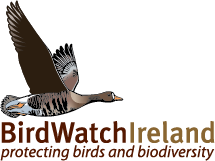
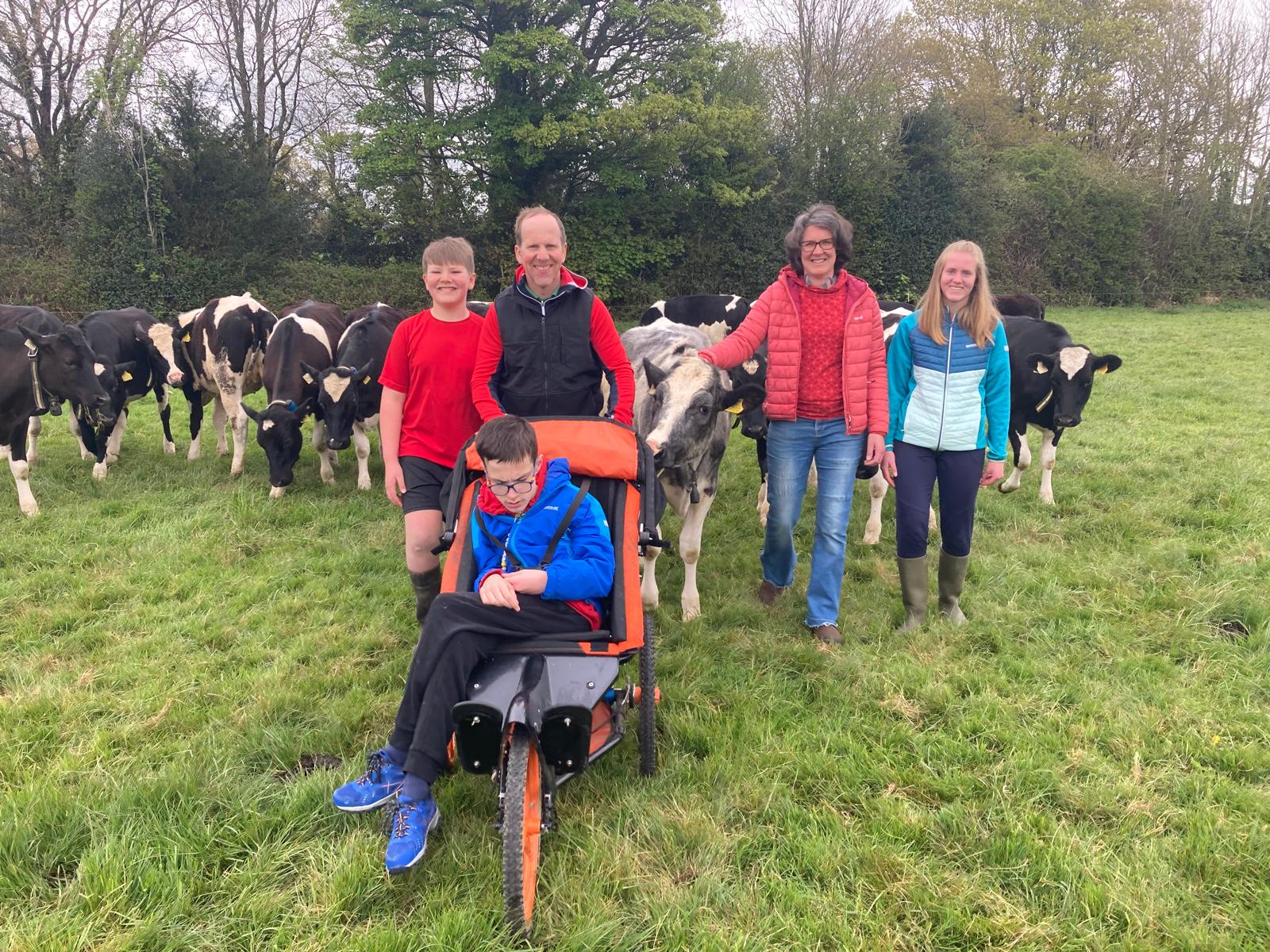
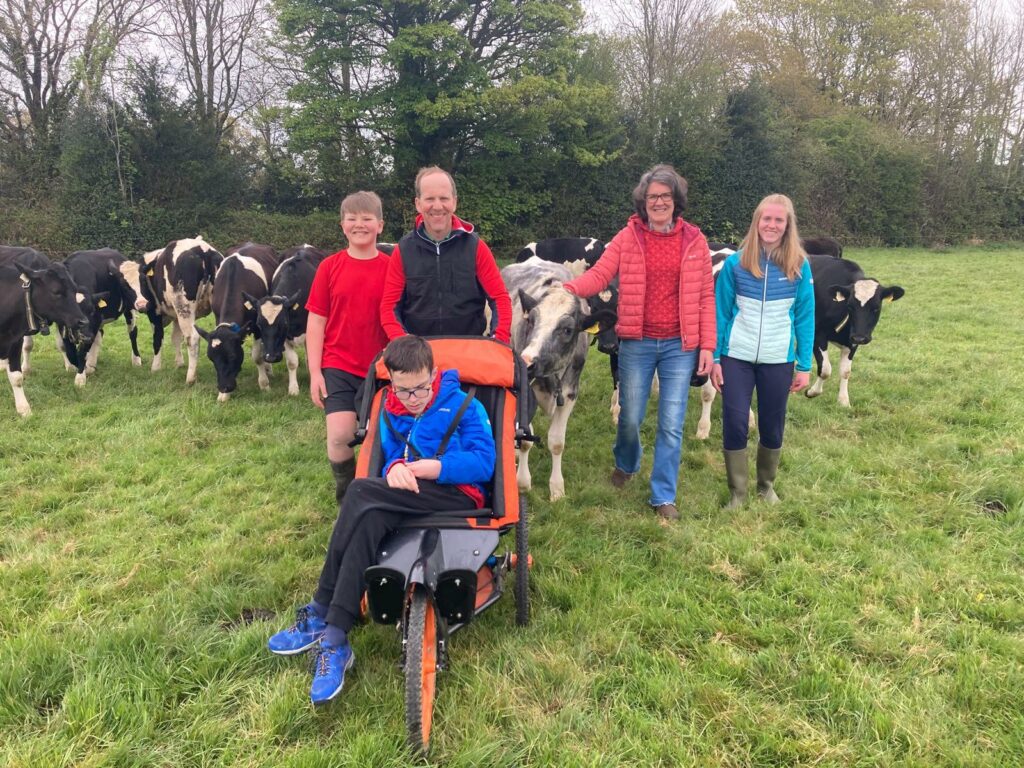 Alan and Cheryl Poole, with their family. (Matthew Moylan)
Alan and Cheryl Poole, with their family. (Matthew Moylan)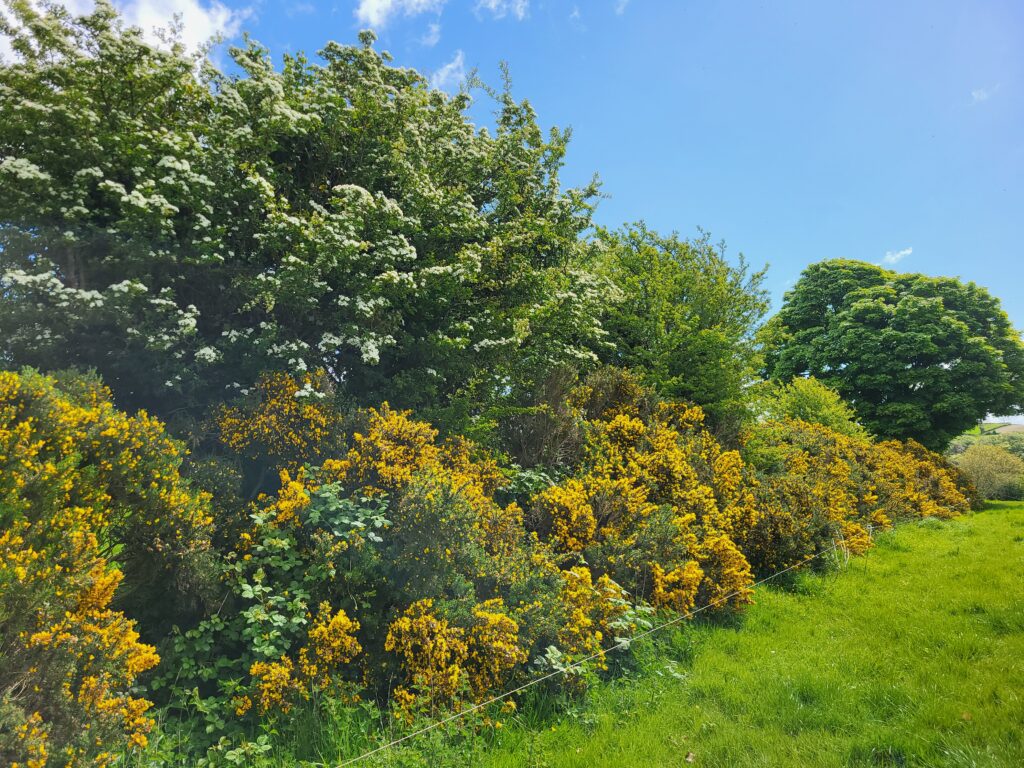 Hedgerows that have been allowed to grow on the Poole farm. (Cheryl Poole).
Hedgerows that have been allowed to grow on the Poole farm. (Cheryl Poole).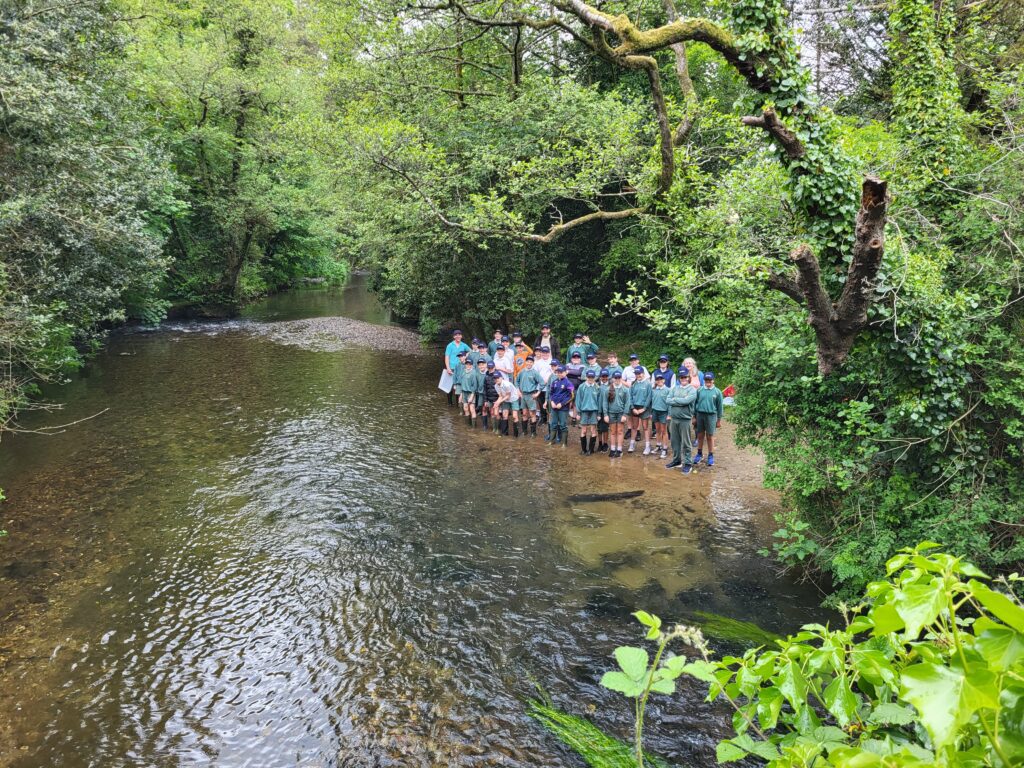 A school group on the Pooles’ section of the River Bann. (Cheryl Poole).
A school group on the Pooles’ section of the River Bann. (Cheryl Poole).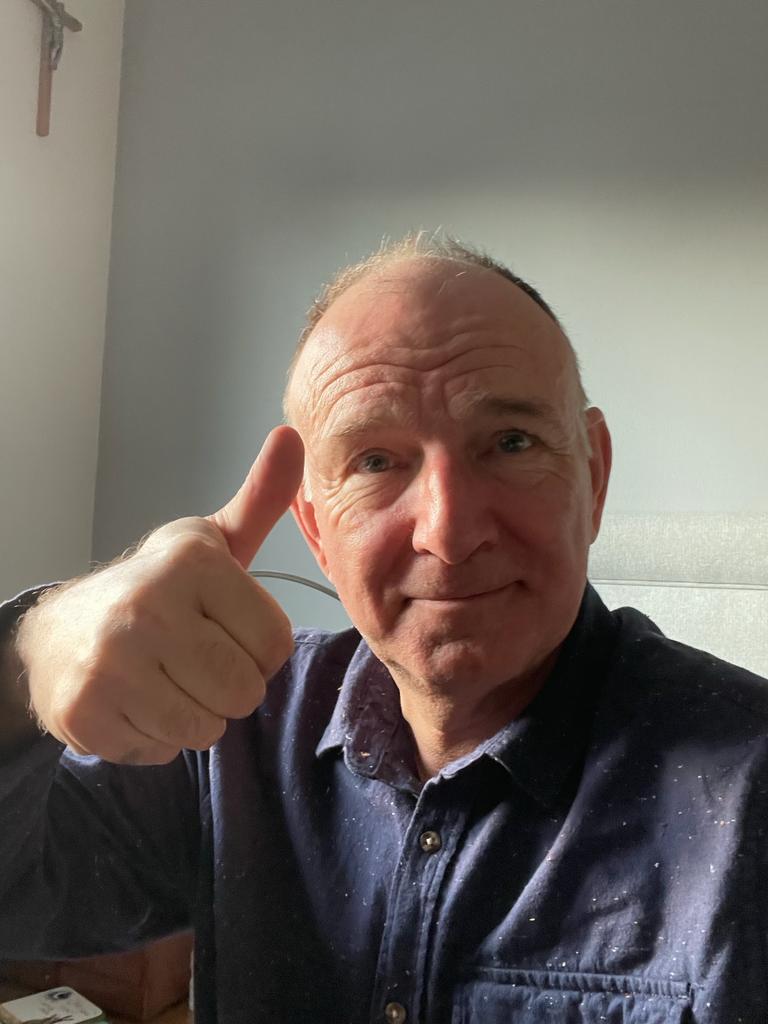 Mark Stanley. (Selfie).
Mark Stanley. (Selfie).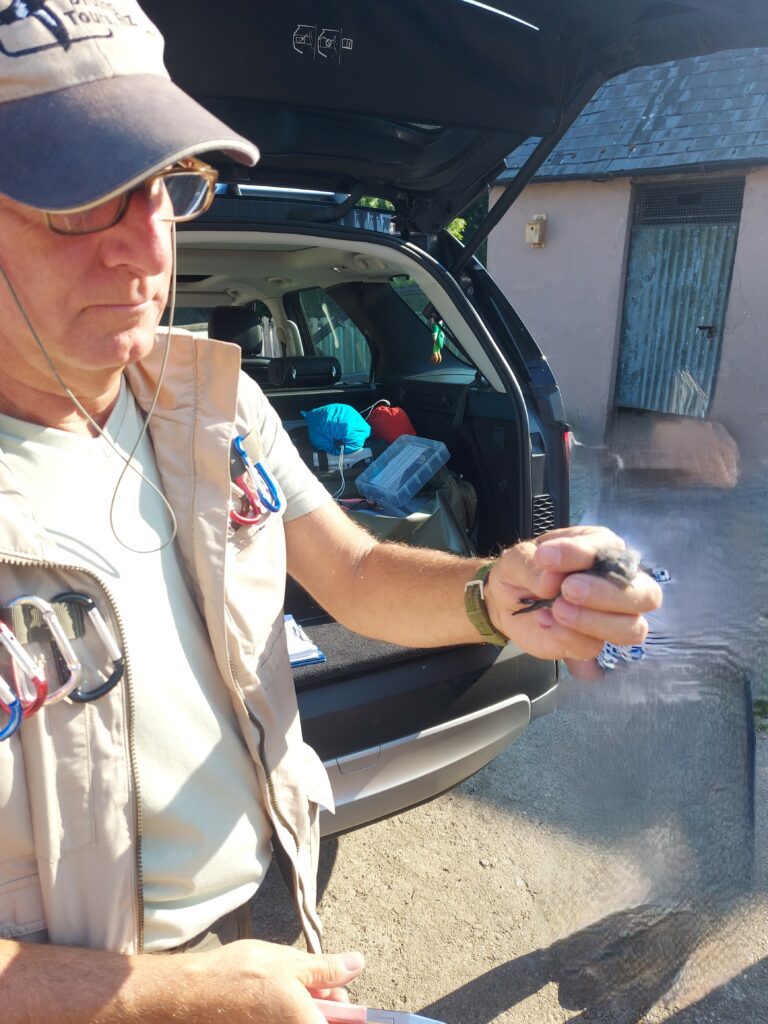 Mark Stanley ringing a Barn Swallow. (Cheryl Poole).
Mark Stanley ringing a Barn Swallow. (Cheryl Poole).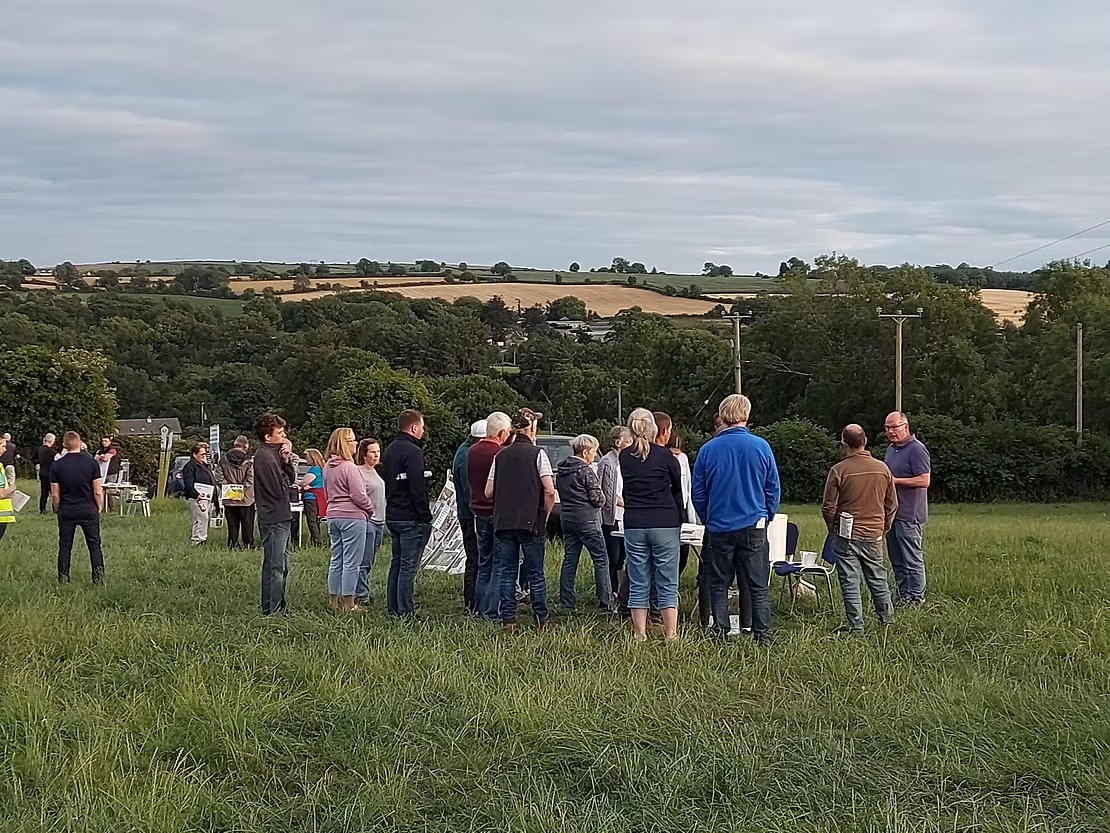 Open day on the Poole farm. (Cheryl Poole).
Open day on the Poole farm. (Cheryl Poole).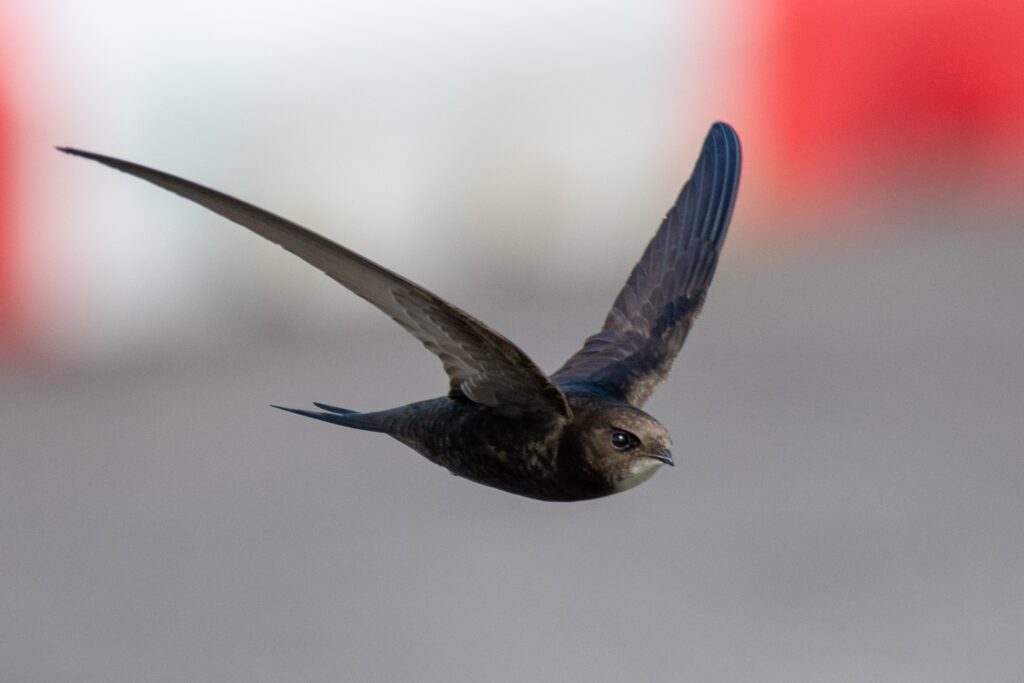 Swift. (Piotr Rak).
Swift. (Piotr Rak).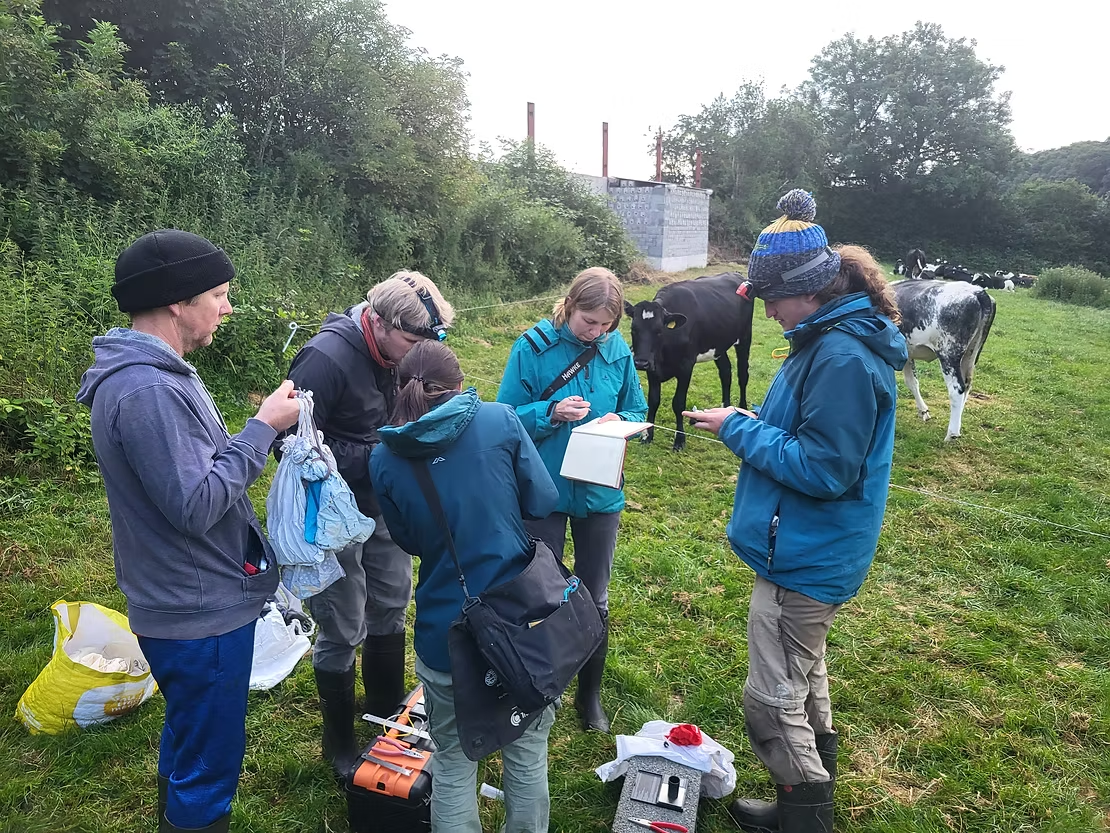 James O’Neill and colleagues ringing Sand Martins on the Poole farm. (Cheryl Poole).
James O’Neill and colleagues ringing Sand Martins on the Poole farm. (Cheryl Poole).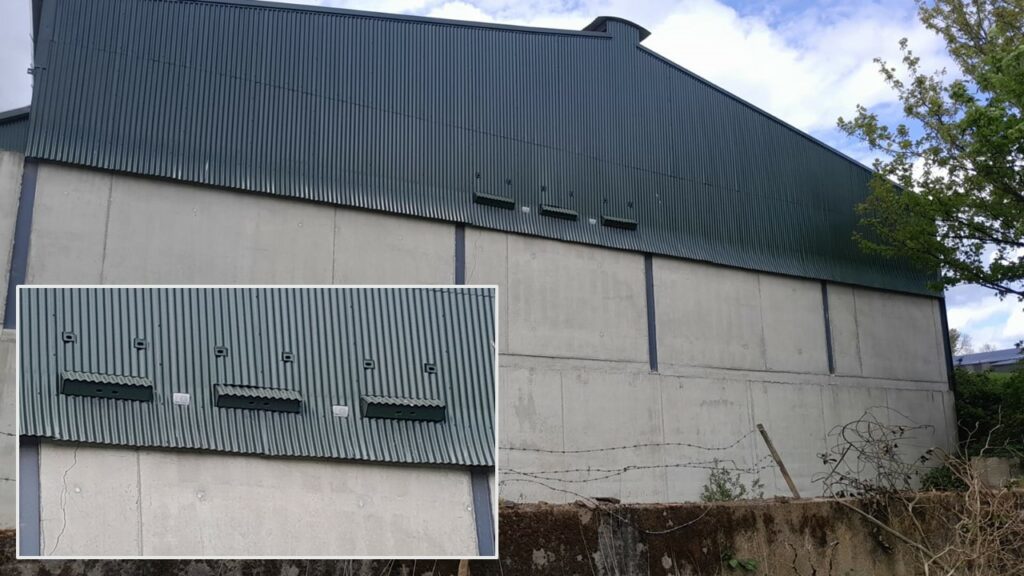 Swift nest boxes in the gable end of a shed on the Poole farm. The three Swift nest boxes installed the first year are on the bottom, covered with metal sheeting to waterproof them. The second set of nest boxes are above, with a ‘porch’ installed at the nest entrance, meaning that a much smaller cut needed to be made to accommodate the nest entrance rather than the entire box. (Cheryl Poole).
Swift nest boxes in the gable end of a shed on the Poole farm. The three Swift nest boxes installed the first year are on the bottom, covered with metal sheeting to waterproof them. The second set of nest boxes are above, with a ‘porch’ installed at the nest entrance, meaning that a much smaller cut needed to be made to accommodate the nest entrance rather than the entire box. (Cheryl Poole). 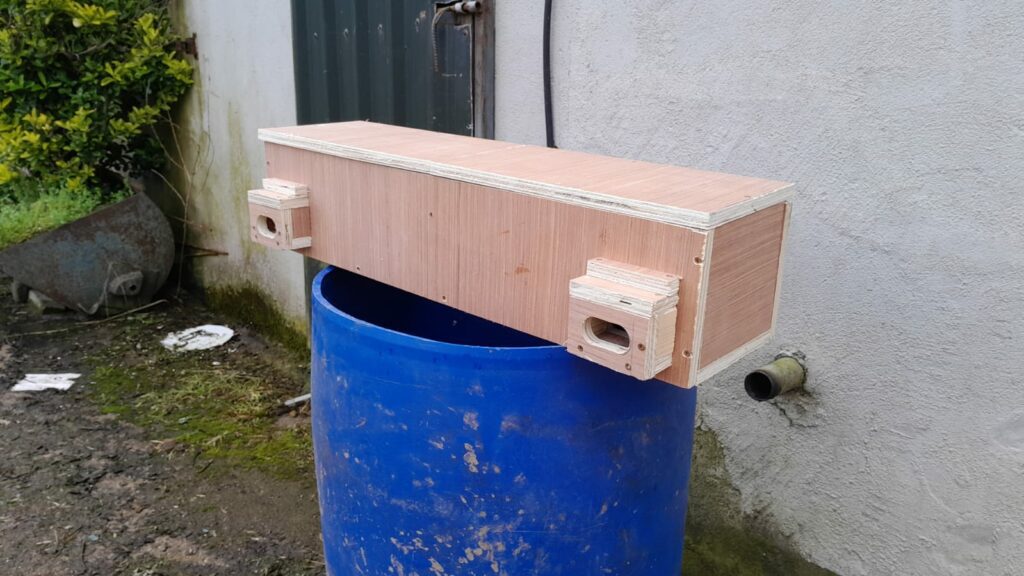 ‘Porches’ built on the Swift box nest entrance. (Cheryl Poole).
‘Porches’ built on the Swift box nest entrance. (Cheryl Poole).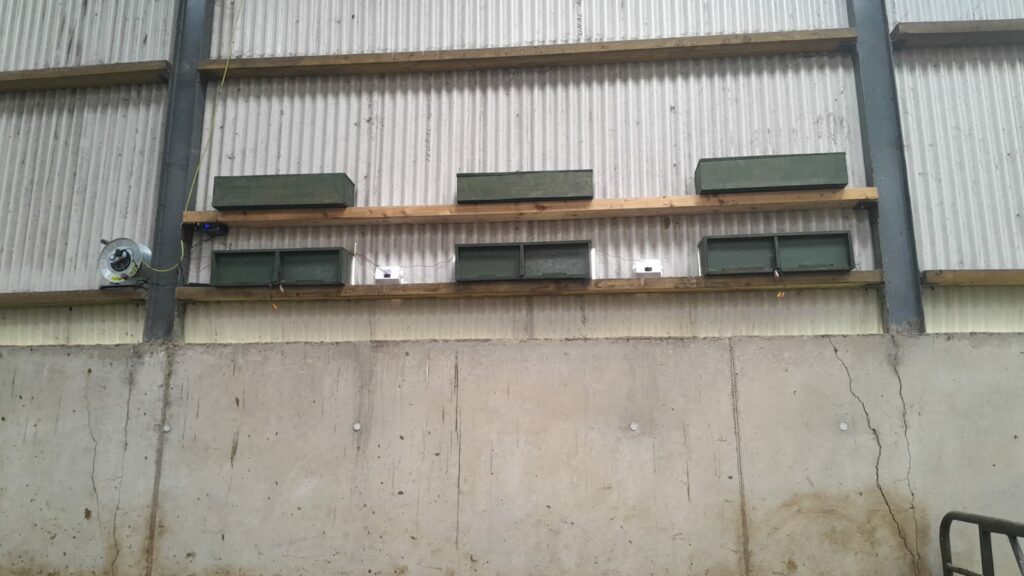 The back of the six Swift nest boxes installed on the gable end of a shed on the Poole farm. (Cheryl Poole).
The back of the six Swift nest boxes installed on the gable end of a shed on the Poole farm. (Cheryl Poole).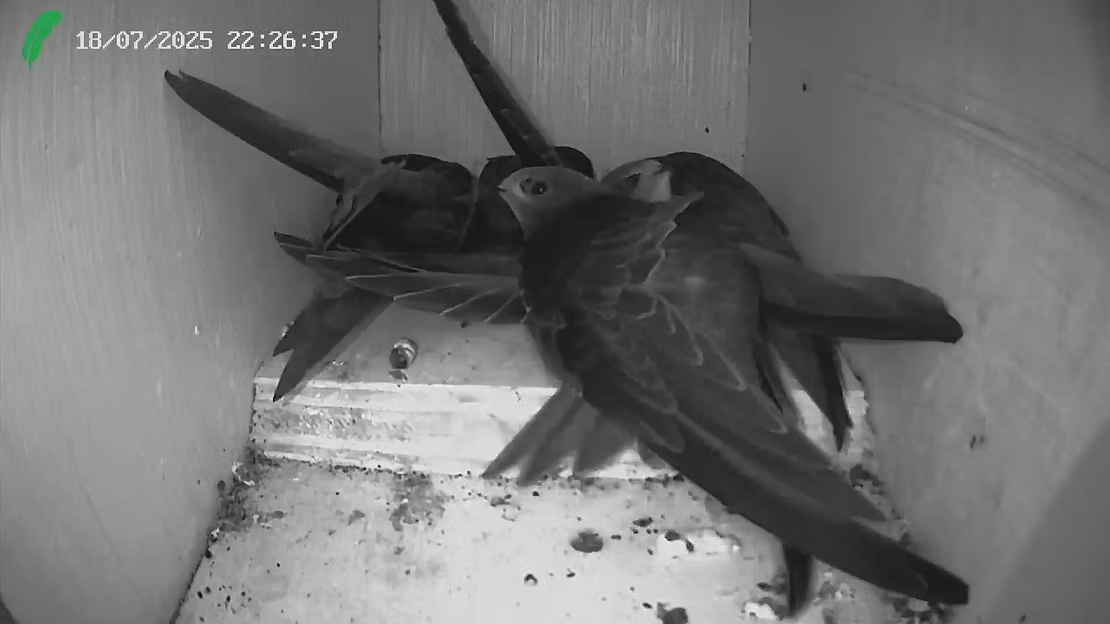 Two adult and two young Swifts in a Swift box on the Poole farm – captured on a nest box camera.
Two adult and two young Swifts in a Swift box on the Poole farm – captured on a nest box camera. 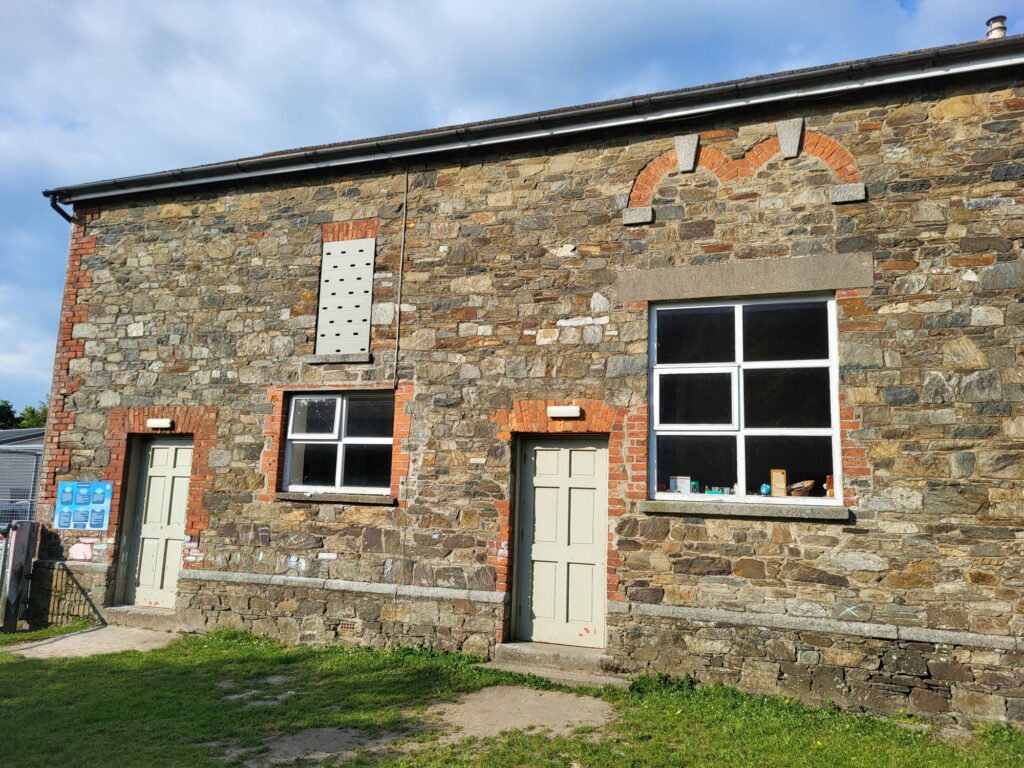 Swift ‘apartment block’ installed in the old national school in Gorey. Swifts are nesting under the eaves of the building. (Cheryl Poole).
Swift ‘apartment block’ installed in the old national school in Gorey. Swifts are nesting under the eaves of the building. (Cheryl Poole).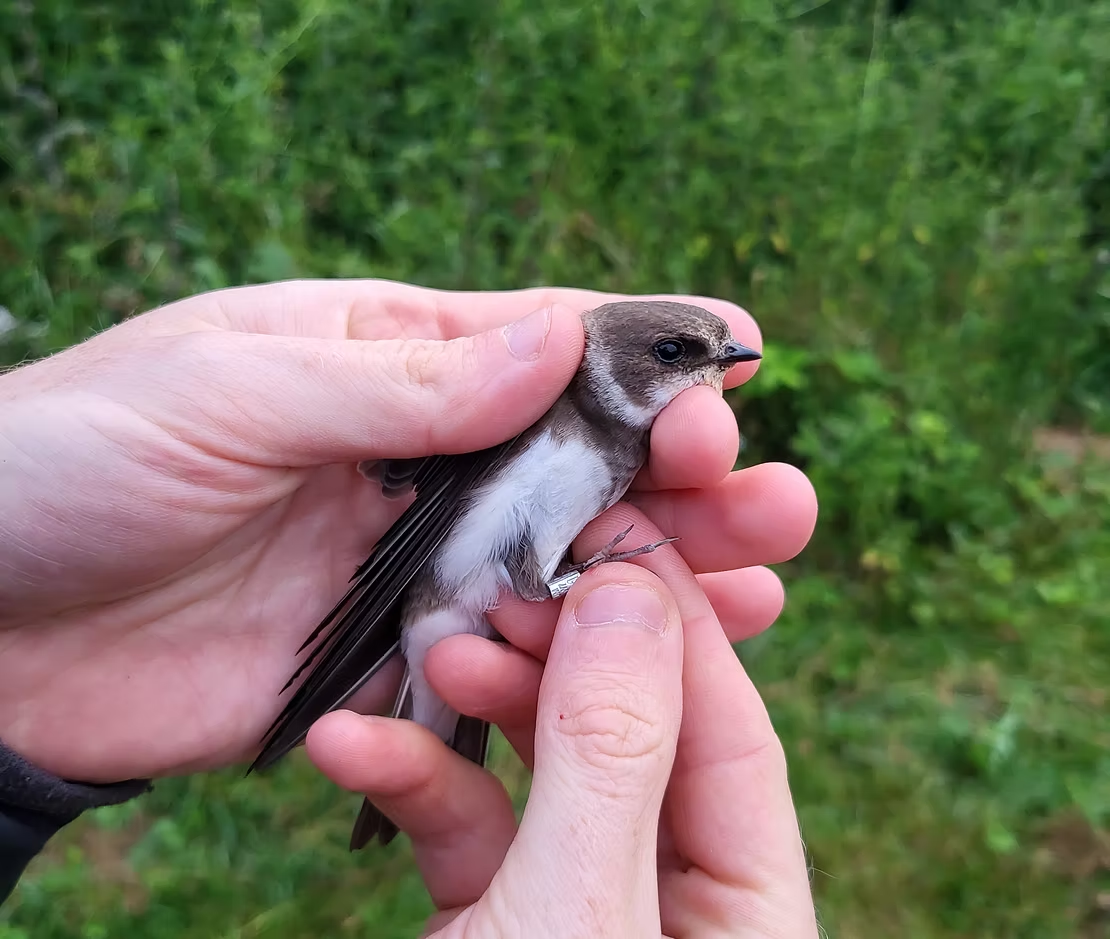 Sand Martin, metal ringed on the Pooole farm. Each metal ring has a unique code which individually identifies that bird.
Sand Martin, metal ringed on the Pooole farm. Each metal ring has a unique code which individually identifies that bird.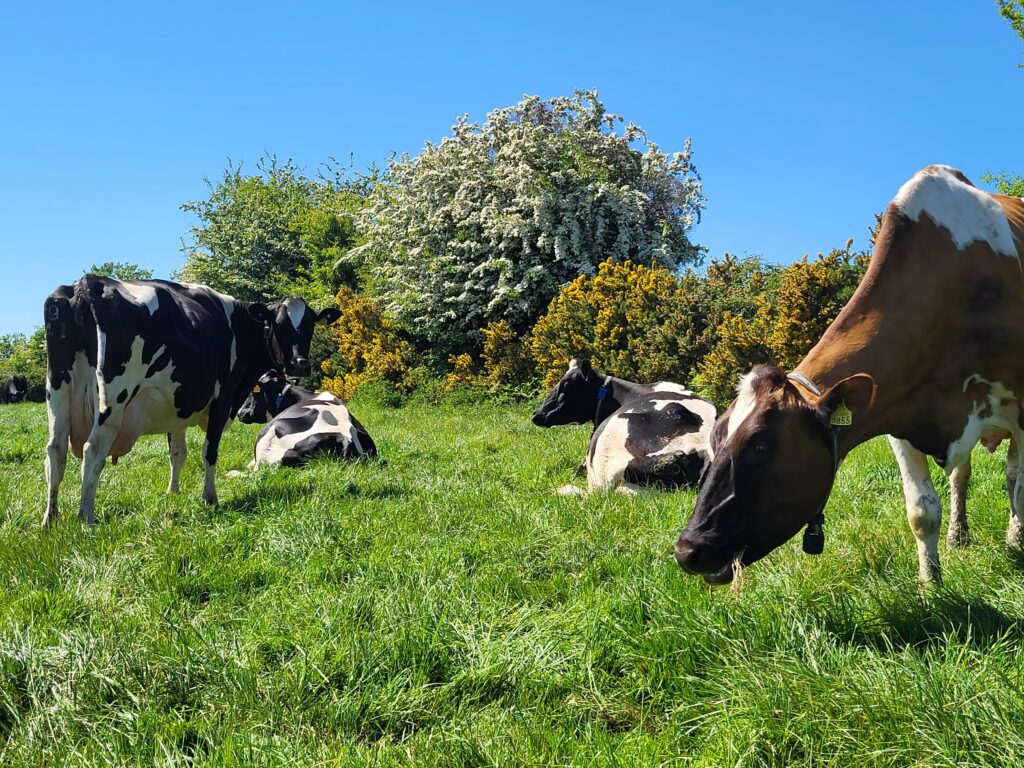 The Poole farm. (Cheryl Poole).
The Poole farm. (Cheryl Poole).